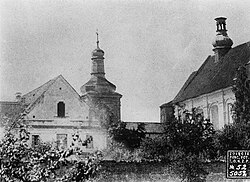Kimbarowka Monastery
| Cistercian monastery Kimbarowka | |
|---|---|

|
|
| location |
Mazyr , Homelskaya Woblasz |
| Coordinates: | 52 ° 3 ′ 0 ″ N , 29 ° 14 ′ 0 ″ E |
| founding year | 1711 |
| Year of dissolution / annulment |
1842 |
| Mother monastery | Vistychy Monastery |
| Primary Abbey | Morimond Monastery |
The Kimbarowka Monastery (Vallis umbrosa; Ciemna dolina) was a Cistercian priory founded in 1711 by the Vistychy Monastery ( Polish : Wistycze) near Brest (Belarus) in the Kimbarowka municipality on the Pripyat of the city of Mazyr in Belarus.
history
The monastery, donated by the Kiev cupbearer Sigismund Szukszta, which was recognized by the Polish estates in 1717 and which, through its founding monastery and Wąchock monastery, is included in the filiation of the Morimond primary abbey , was subordinated to the Oliva and Pelplin monasteries by the general chapter in 1758 . In 1743, the nunnery of the Vallis angelica monastery (Anielska dolina) belonging to the Cistercian order was founded in Kimbarowka . Kimbarowka Monastery merged with the other two Cistercian monasteries and the Benedictine monasteries in what was then Lithuania, which had become Russian, to form a special congregation, which in 1811 also joined a Camaldolese monastery and later a Carthusian monastery. The monastery existed until 1842, but the monks only left it in 1864 when they moved to the Benedictine monastery in Horodyszcze, while the prior and seven other monks were exiled to the Amur . In the Second World War, a school and a boarding school were established. In 1990 the church was returned to the Roman Catholic cult .
Plant and buildings
The baroque monastery complex was built in 1711. The 1745 built single-nave, the Assumption church, dedicated high roof and pilastergeschmückter facade with capitals and a profiled cornice was among the kings Augustus II. And Augustus III. richly endowed. The stone-built monastery had the sacristy, the chapter house, the refectory, rooms for the novices and five monks' cells on the ground floor, and the prior's rooms, the library with 850 works and other cells on the upper floor. A farm building also belonged to the monastery.
Individual evidence
- ↑ Cistercienser Chronik Vol. 2 (1890) pp. 17-18
- ↑ http://www.cistopedia.org/index.php?id=6680
- ↑ Cistercienser Chronik Vol. 2 (1890) pp. 17-18
- ↑ Cistercienser Chronik Vol. 4 (1892), 134
literature
- Grzegorz Rąkowski: Illustrowany przewodnik po zabytkach kultury na Białorusi. Burchard edition, Warszawa 1997, ISBN 83-904446-9-0 , p. 149.
- Information about the Kimbarowka Monastery. Cistercienser Chronik 4 (1892), pp. 134-137, on the Internet at http://www.archive.org/stream/Cc1-4/Cc1-4_djvu.txt .
- The Cistercienser in Lithuania (short notes) , Cistercienser Chronik 2 (1890), pp. 17-18, on the Internet at http://www.archive.org/stream/Cc1-4/Cc1-4_djvu.txt .